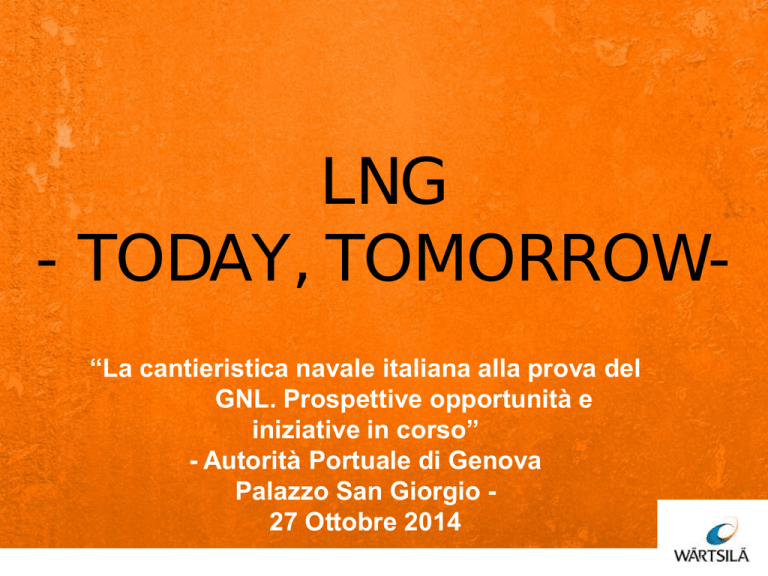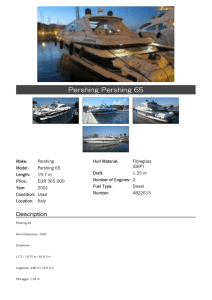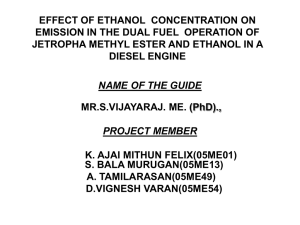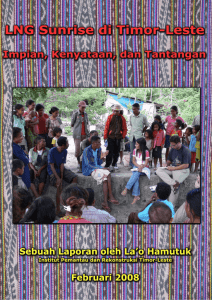engine - ConferenzaGNL
advertisement

LNG - TODAY, TOMORROW“La cantieristica navale italiana alla prova del GNL. Prospettive opportunità e iniziative in corso” - Autorità Portuale di Genova Palazzo San Giorgio 27 Ottobre 2014 Summary • WHY LNG • STATUS QUO AND NOVELTIES • THE EXPERIENCE IN THE MECHANICAL DRIVES APPLICATIONS • TOMORROW’S CHALLENGES 2 © Wärtsilä WHY LNG Environment LOCAL NOx LOCAL Acid rains Tier II (2011) Tier III (2016) LOCAL Particulate matter 4 © Wärtsilä SOx Acid rains Sulphur content in fuel from 2015 worldwide GLOBAL Direct impact on humans Locally regulated CO2 Greenhouse effect Energy Efficiency Design Index (EEDI) Fuel prices trends Fuel price [USD/MMBTU] 35,0 Marine Gas Oil Rotterdam Marine Diesel Oil Rotterdam 180 Centistoke Rotterdam 380 Centistoke Rotterdam Henry Hub (Natural Gas) 30,0 25,0 20,0 15,0 10,0 ? 5,0 0,0 5 © Wärtsilä Revised Marpol Annex VI Regulation 13 Wärtsilä standard NOR is dimensioned for reaching the IMO Tier 3 level. NOX (g/kWh) 18 16 14 12 10 8 6 4 2 0 Primary methods operation area Tier I >130 kW New ships 2000 Wärtsilä NOR operation area 0 200 400 600 800 Tier II >130 kW New ships 2011 Secondary methods operation area 1000 1200 1400 1600 1800 2000 Rated engine speed (rpm) 6 © Wärtsilä Tier III >130 kW Upcoming requirement, New ships inside Emission Control Areas (ECA) Marine sulphur limits Sulphur limit (%) 4.5 World 3.5 –97% –86% ECA 2022 2021 2020 2019 2018 2017 2016 2015 2014 2013 2012 California 2011 2010 2009 1.5 1.0 0.5 EU in ports 0.1 2008 –71% –78% –67% Review of the 0.5% S global limit to be performed in 2018. In case readiness is not deemed to be sufficient by 2020, the introduction of the limit will be postponed to 2025. Fuel type Exhaust gas cleaning Particulate Matter (PM) 7 © Wärtsilä Not regulated = both HFO and distillate are permitted. Permitted alternative under Regulation 4 to achieve any regulated limit. No limit values. Emission Control Area (ECA) landscape 8 © Wärtsilä NOX compliancy How to comply with recently confirmed IMO Tier III? Catalyst Natural Gas (Nitrogen Oxides Reducer) ...or... 9 © Wärtsilä SOX compliancy How to comply with Sulphur limits? Change fuel ...or... 10 © Wärtsilä Natural Gas Scrubber (low sulphur distillates) ...or... STATUS QUO AND NOVELTIES Dual-fuel application references LNG Carrier Multigas Carrier Ro-Ro Bulk Carrier Conversion Merchant 150 vessels 5 vessels 2 vessels 1 vessels 1 vessels ~ 650 engines OSV’s • 31 vessels • 96 engines 6 segments 12 © Wärtsilä Navy Production • 2 platform • 9 FPSO’s etc. • 1 FSO • 40 engines Offshore Cruise & Ferry Coastal Patrol • DF-propulsion • DF main and auxiliary engines TUG • 2 vessel • 2 engines each • Mechanical drive Others LNG Cruise ferry • 1 vessels • 4 engines • Complete gas train LNG ferries • 4 ferries • 18 engines Conversion • 1 ferry • 2 engines DF Power Plant • 67 installations • 354 engines • Output 4600 MW • Online since1997 Power Plants >1,000 engines >10,000,000 running hours Guide Ship • 1 vessel /engine IWW • 2 vessel • 3 engines LNG as cargo LNG is never stable in cargo tanks flexibility is the reason why DF-E has been successful 13 © Wärtsilä LNG as marine fuel LNG is lighter than Diesel but requires more space System integration and Ship Design are key factors LNG tanks (2 x 500 m3) Dual Fuel engines (2 x W6L50DF) 14 © Wärtsilä Wärtsilä 2-stroke DF – Deliveries Engine type Expected drawing delivery of Expected first engine delivery main components RT-flex50DF Q2 2014* Q1 2015** W-X62DF Q4 2014* Q3 2015** W-X72DF Q2 2015* Q1 2016** W-X52DF Q3 2015* Q2 2016** W-X82DF Q4 2015* Q3 2016** * Expected final drawing delivery is subject to order ** Expected engine delivery varies but is normally obtained 6 – 12 months after final drawing delivery 15 © Wärtsilä Dual Fuel 2-stroke Design principles: High efficiency Low pressure Meets IMO Tier III without treatments 16 © Wärtsilä 2-stroke DF - Key Technologies Micro pilot’ and Pre-chamber technology • Electronically controlled injectors + Common Rail fuel supply • Pilot fuel (for ignition) only 1% minimizing fuel costs • Pre-chamber technology for best combustion stability and reduced emissions • Technology developed and proven on 4-stroke • Option for HFO as pilot will be available Pre-chamber 17 © Wärtsilä 2-stroke DF - Key Technologies Engine control and automation system Exhaust valve Pilot fuel pressure Gas pressure Control system Engine speed/ CA-signal Engine stop signal Gas duration Pilot fuel injectors 2x Gas admission valves Pilot fuel injector Gas admission valves Exhaust valve drive 18 © Wärtsilä 08 January 2014 Wärtsilä 2-STROKE / Ingemar Nylund • Wärtsilä ‘UNIC’ based control system • All essential controls in one system • Individual control of combustion related parameters – optimized engine performance • Inbuilt Redundancy for ’single main engine’ application • Safety functions related to gas operation including knock- and misfire detection Leading into the Gas age – references! INTO the FUTURE --Baltic SO2lution Ship type: 2+2 x 15’000 dwt Chemical tankers Owner: Terntänk of Sweden Shipyard: AVIC-Dingheng in China Vessel delivery date: early 2016 Engine type: Wärtsilä 5RT-flex50DF 19 © Wärtsilä Leading into the Gas age – references! • Ship Type: 14’000 m3 LNG Carrier • Owner: Zhejiang Huaxiang Shipping Co., Ltd – Private shipping company – Major player in LPG transportation market – One of the owners who acquired the route rights of LNG transportation in China domestic water • Shipyard: Qidong Fengshun Ship Heavy Industry Co., Ltd, • Delivery date: Sept. 2015 • Engine type: Wärtsilä 5RT-flex50DF 20 © Wärtsilä 4-stroke DF Portfolio & Applications 20DF 0.5 -1.8 MW 34DF 5.8- 17.5 MW > 750 Engines sold for Marine use > 600 engines 50DF > 100 engines 34DF > 50 engines 20DF 21 © Wärtsilä • • • • Small LNG / CNG vessel Small cargo vessels Supply vessel Offshore application & Production Aux. engines with W46/50DF • • • • • 50DF 5 LNG Feeder Jack-up Tugs Small cargo vessels Barges Small ferries Aux. engines with W34DF & W50DF • 2,8 – 8,0 MW 0 • • • • • • • 10 15 20 LNG Carriers Cruise ships RO-RO/PAX Ferries Large Offshore Units 4-stroke DF Portfolio & Application types 20DF 0.5 -1.8 MW 34DF 3,0 – 10,0 MW 50DF 5.8- 17.5 MW 46DF 6.2 -18.3 MW 0 22 © Wärtsilä 5 10 15 20 • • • • • • • LNG Feeder Jack-up Tugs Small cargo vessels Barges Small ferries Aux. engines with W34DF & W50DF • • • • • Small LNG / CNG vessel Small cargo vessels Supply vessel Offshore application & Production Aux. engines with W50DF • • • • • LNG Carriers Cruise ships RO-RO/PAX Ferries Large Offshore Units • • • • • LNG Carriers Cruise ships RO-RO/PAX Ferries Large Offshore Units Dual Fuel 4-stroke Design principles: High efficiency Low pressure Meets IMO Tier III without treatments 23 © Wärtsilä EXPERIENCES IN THE MECHANICAL DRIVE APPLICATIONS Experience And Development Wärtsilä DF proven solution : • Load taking capability • Intrinsic redundancy – no interruption of operations • Safety and fuel flexibility • Application experience with mechanical drive, single main engine 25 © Wärtsilä Safety and flexibility Full flexibility Can start/stop/idle in gas mode Can operate on all loads in gas mode Can operate on one lube oil for all fuels Can operate on cheapest fuel available Full redundancy no need for additional equipment if failure: Instant safety backup maintaining full power and speed 26 © Wärtsilä Automatic safety trip 100 % 0 Diesel mode Gas mode Gas mode operation from 0 – 100% MCR diesel mode at any load 110 % % Load Dual Fuel engine can transfer instantly to DF Loading test 0–100%, Gas Operation Engine load Engine speed *Frequency variation ~2% Engine load [%] Engine speed [rpm] Gas inject. Duration [time] *Class requirement max 10% deviation Loading ramp is done in test conditions, demonstrative and valid for laboratory only 27 © Wärtsilä DF Loading test 0–100% Gas + Diesel Operation Simulated gas system failure Engine speed Engine load DF redundancy proves even in full power ramp-up an sudden failure in the gas system does not compromise safety Engine load [%] Engine speed [rpm] Gas inject. Duration [time] Loading ramp is done in test conditions, demonstrative and valid for laboratory only 28 © Wärtsilä Dredgers: Wärtsilä DF latest development 34DF W6L34DF load step variation succesfull test specific for dredger application, held on August 2013 Load step test for Duel Fuel 34 engine 120 100 Power [%] 80 60 40 20 0 0 2 4 6 8 10 12 14 16 18 20 22 24 26 28 30 32 34 36 38 40 42 44 46 48 50 52 54 56 58 60 62 64 66 68 70 72 74 76 78 80 82 84 86 88 90 92 94 96 98100102104106108110112114116118120122124126128130132134136138140142144146148150152154156158160162164166168170172174176178180182184 Time [min] Loading program done in test conditions, demonstrative and valid for laboratory only 29 © Wärtsilä LPG Carrier: Evergas – Mechanical drive Fuel Supply Reliquefaction Auxilliary engines Cargo Handling Propulsion Gear 30 © Wärtsilä Main engines Tank Design LPG Carrier: Evergas – Mechanical drive Twin in – Single out TCH350 Shaft Twin engine New York 6L50DF CPP 4E1540 31 © Wärtsilä Twin in – Shaft generator Single out 1’600kW TCH350 LPG Carrier: 4700 m3 – Anthony Veder Main engine Shaft generator PTO CPP 32 © Wärtsilä Shaft W6L34DF Gear Vertical LNGC : 15600 m3 Coral energy Main engine Shaft CPP 33 © Wärtsilä Shaft generator PTO W8L50DF Gear Vertical Tug boat : 80ton Bollard pull - CNOOC Main engines W6L34DF 34 © Wärtsilä IWW – LPG Carrier : Chemgas BV Owner : Chemgas Shipping BV Delivery : Q4 – 2013 Amount of vessels: 2 “First W20DF + FPP application” Wärtsilä scope of supply: • 1*W8L20DF (main engine) • FPP with nozzle GEAR 35 © Wärtsilä W8L20DF Chemical Tanker: Bit viking - DF conversion Main engine Shaft CPP 36 © Wärtsilä W6L50DF Shaft generator Gear PTO Vertical DF for mechanical drive • Bit Viking - The First vessel – – – – – The First gas conversion The First Diesel Mechanical gas engine First Dual-Fuel “single main engine” approval The First Wärtsilä gas handling system The First non LNGC gas powered merchant vessel .... and a happy owner Before 37 © Wärtsilä After Background - Main engines conversion before 2 x W6L46B 5850 kW each CPP PTO 1500 kW WÄRTSILÄ 8L20 1200 kW CPP WÄRTSILÄ 8L20 1200 kW PTO 1500 kW after 2 x W6L50DF 5700 kW each 38 © Wärtsilä DF mechanical propulsion - Operational experience Date 1.12.2011 Time 22:15 Vessel speed 14,3 knots Latitude N 57°58‘ Longitude E 6°4' Heading 100° Wind speed 10,5 m/s Wind direction 290° Wave height (avg.) 4-5 m Draught 8m Waves direction 290° 39 © Wärtsilä NORWAY DF mechanical propulsion - Operational experience 100 1000 Engine load 900 90 Engine speed 800 700 600 70 500 60 400 300 50 200 40 100 30 0 0 40 © Wärtsilä 50 100 Time [s] 150 200 Engine speed [rpm] Engine load [%] 80 DF mechanical propulsion - Operational experience 100 1000 85% 90 83% 514 600 70 500 60 400 300 200 486 40 37% rpm 100 30 0 0 50 100 150 200 Time [s] 8s Engine speed [rpm] Engine load [%] 700 50 © Wärtsilä Engine speed 800 rpm 80 41 Engine load 900 Operating hours 24.10.2011 – 5.11.2012 Operating hours 5000 4000 Gas 3000 2000 1000 Diesel 0 24.10.2011 7.1.2012 22.3.2012 5.6.2012 19.8.2012 2.11.2012 • Carbon contents in fuel estimated as follow: – HFO: 85%-w, LNG: 75% • Bit Viking saving in annual CO2 production – 4500 ton CO2 42 © Wärtsilä TOMORROW’S CHALLENGE Lng:: THE LOGISTIC CHAIN AND Wärtsilä CONTRIBUTION Lng Distribuzione & Trasporto Generazione Energia Small-scale LNG plants Terminale di liquefazione LNG LPG/LNG tanker Terminale LNG & Rigassificazione (FSRU/JRU) Barges & Stazioni LNG fuelled Rifornimento LNG vessels LNG carrier LNG fuelled vessels Produzione FPSO Esplorazione & Sviluppo Campo Esplorazione & Sviluppo Campo • Analisi Campo e successiva Trivellazione 44 Produzione & Liquefazione • Piccole stazioni di Liquefazione a Terra e in Mare • Gas FPSO Trasporto & Stoccaggio Terminali di Ricezione & Rigassificazione Distribuzione & Trasporto • Sistemi di propulsione • Gestione carichi LNG • Distribuzione e Logistica a Gas • Rigassificazione Jetty di Gas/LNG • Impianto di Generazione & Floating • Sistemi di Trasporto LPG, LEG & LNG • Terminali di Ricezione Energia Wärtsilä FROM DRILLING... Esplorazione & Sviluppo Campo • Sistemi di propulsione a LNG per OSVs 45 Produzione & Liquefazione • Piccole stazioni di Liquefazione a Terra e in Mare antiflaring/VOC Trasporto & Stoccaggio • Sistemi di propulsione a Gas • Sistemi di Trasporto LPG, LEG & LNG ...TO THE END USERS LNG come combustibile per trasporto: Supply Chain in una Produzione di LNG di piccola scala Trasporto LNG Carrier Rigassificazione LNG Stoccaggio e Rifornimento Distribuzione Utenze Terminale Rigassificazione Generazione Energia Convenzionale Domanda di Gas crescerà a ~2% CAGR nel 2035 Small LNG Carrier Marittimo: Terminale a distribuzione 10% del totale consumo di LNG (crescita prevista fino al 14% nel 2025) Terminali LNG Bunker Vessel LNG Fuelled Vessel Liquefazione Strada LNG Trailer Truck Terminale a Truck Stazioni di Rifornimento 46 LNG Fuelled Truck Thank you for your attention 47 © Wärtsilä


